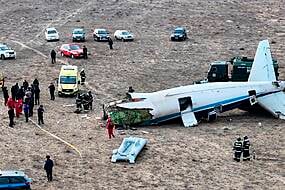Three astronauts who lived for 90 days on China’s space station left Thursday in preparation for a return to Earth.
The national space agency said Nie Haisheng, Liu Boming and Tang Hongbo have boarded the Shenzhou-12 spacecraft and undocked from the space station.
State broadcaster CCTV aired footage of the astronauts securing packages inside their spacecraft, which is due to parachute to a location in the Gobi Desert near the Jiuquan launch centre on Friday.
The astronauts have already set China’s record for the most time spent in space.
After launching on June 17, mission commander Nie and astronauts Liu and Tang went on two spacewalks, deployed a 10-metre mechanical arm, and had a video call with Communist Party leader Xi Jinping.
Before the undocking, the astronauts downloaded data from their experiments and ensured the station would continue operating without a crew, CCTV reported.

The journey home is expected to take at least 30 hours, CCTV said. Before departing, Nie and his colleagues expressed their thanks for the “round-the-clock support and devotion from all the staff”.
Four drills have been conducted on the ground at the Dongfeng landing site in north China’s Inner Mongolia Autonomous Region to ensure the safe return of the crew.
While few details have been made public by China’s military, which runs the space programme, astronaut trios are expected to be taken on 90-day missions to the station over the next two years to make it fully functional.
The government has not announced the names of the next set of astronauts nor the launch date of Shenzhou-13.
China has sent 14 astronauts into space since 2003, when it became only the third country after the former Soviet Union and the United States to do so on its own.
When completed with the addition of two more modules, the station will weigh in at about 66 tons, a fraction of the size of the International Space Station, which launched its first module in 1998 and will weigh around 450 tons when completed.

In preparation for the permanent station, China launched two experimental modules over the past decade.
Tiangong-1 was abandoned before it burned up during an uncontrolled loss of orbit. Its successor, the Tiangong-2, was brought out of orbit in 2018 under full control.
China launched its bid to build such facilities in the early 1990s following successes in earlier missions and its exclusion from the International Space Station, largely due to US objections over the Chinese programme’s secretive nature and close military ties.
China has also pushed ahead with un-crewed missions, particularly in lunar exploration.
It has placed a rover on the little-explored far side of the moon and in December, the Chang’e 5 probe returned lunar rocks to Earth for the first time since the 1970s.
China this year also landed its Tianwen-1 space probe on Mars, with its accompanying Zhurong rover venturing out to look for evidence of life.
China also plans to dispatch another mission in 2024 to bring back lunar samples and has expressed a desire to land people on the moon and possibly build a scientific base there, although no timeline has been proposed for such projects.







